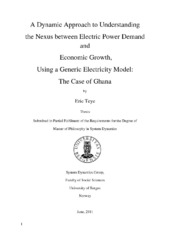| dc.description.abstract | The debate about the interplay between energy and economic growth continues unabated without any indication of a consensus being reached. While some research work point to a unidirectional relationship between energy consumption and economic growth, others point to a bi-directional relationship between the two. The contrasting results are due to the use of different data sets, alternative methodologies; and different countries' characteristics such as indigenous energy supplies, different political/economic histories, political arrangements, culture, et- cetera (Ozturk 2010). In Ghana, Wolde-Rufael (2009) and Akinlo (2008) found a bi-directional relationship between energy consumption and economic growth. They suggested that energy consumption and growth are reinforcing. But no real quantity grows forever (Sterman, 2000 p. 285). This paper uses System Dynamics tools to explore how feedbacks, delays and nonlinearities play out between energy (with specific reference to electricity) and economic growth; and seeks to provide policy makers in the power industry an alternative capacity planning tool. | en_US |
